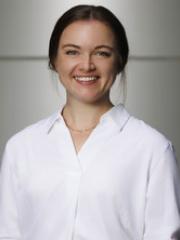Dr Farrah Blades

Dr Farrah Blade's research interests are in cell structure, intra-cellular pathways and in protein structure. During her honours she characterised two mouse models of Multiple Sclerosis, looking at T-cell permeability through the blood-brain barrier and the CXCR4/ CXCL12 chemokine axis.
During her PhD, Farrah found critical roles for the tyrosine kinase receptor, Tyro3, in myelination and retinal ganglion cell function while assessing the neuronal functional outcomes of Tyro3 driven myelin structural deficits.
Following her PhD, Farrah moved to The University of Queensland (UQ) to begin a Post Doctoral Research Fellowship under the supervision of Professor Ben Hankamer, where she focused on cryogenic electron microscopy and single particle analysis of the photosystem II supercomplex. During this time she also helped establish a virtual desktop which runs from the Bunya supercomputer, making research software accessible and easier to use across UQ.
As of 2024, Farrah has begun a post doctoral research position under the supervision of Dr Rosemary Cater, assessing the structure and function of membrane transporter proteins such as FLVCR2 and MFSD2A in the context of the blood-brain and blood-retinal barrier. The goal is twofold: first, to comprehend the fundamental biology of these transporters; second, to discover a mechanism that enables drug access across the blood-brain and blood-retinal barriers. This advancement will facilitate therapeutic treatments for an array of central nervous system diseases.
Researcher biography
My research interests are in cell structure, intra-cellular pathways and in protein structure. During my honors I characterised two mouse models of Multiple Sclerosis, looking at T-cell permeability through the blood-brain barrier and the CXCR4/ CXCL12 chemokine axis. During my PhD I found critical roles for the tyrosine kinase receptor, Tyro3, in myelination and retinal ganglion cell function while assessing the neuronal functional outcomes of Tyro3 driven myelin structural deficits. Following my PhD, I moved to the university of Queensland to begin a post doctoral research fellowship under the supervision of Prof. Ben Hankamer, where I focussed on cryogenic electron microscopy and single particle analysis of the photosystem II supercomplex. During this time I also helped establish a virtual desktop which runs from the Bunya supercomputer, making research software accessible and easier to use across UQ.
As of 2024 I have begun as a post doctoral research fellow under the supervision of Dr. Rosemary Cater, I will be assessing the structure and function of membrane transporter proteins such as FLVCR2 and MFSD2A in the context of the blood-brain and blood-retinal barrier. Our goal is twofold: first, to comprehend the fundamental biology of these transporters; second, to discover a mechanism that enables drug access across the blood-brain and blood-retinal barriers. This advancement will facilitate therapeutic treatments for an array of central nervous system diseases.
